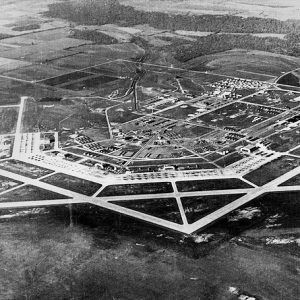calsfoundation@cals.org
Newport Air Field
During World War II, one of the army’s seven training airfields built in Arkansas was located at Newport (Jackson County). Over 4,000 men trained during the three years the Newport Army Air Field was in operation. At one point, over 4,800 people were living on the base, more than doubling Newport’s 1940 population of 4,301.
Newport was chosen as a site through the encouragement of Congressman Wilbur D. Mills. The flat land already lent itself to airport usage as most trees had been cleared and the ground had been drained for farming. The project was announced in the middle of May 1942, and construction began almost immediately. Thirty-four farm families were displaced from the main site, along with those living at the auxiliary sites. The completed airfield consisted of four runways, each 5,000 feet long. The base became a self-contained town, having its own housing, utilities, recreation, and religious facilities. Auxiliary air strips were placed at the Jackson County locations of Erwin and Milltown (paved and lighted runways), as well as the towns of Weldon, Elgin, and Amagon (turf runways). At its completion, the main airfield site covered some 2,837 acres, while the five auxiliary airstrips totaled 2,447 acres. Its 1943 estimated total value was placed at $10.7 million.
Housing was in short supply, and soon Newport was declared to be a Title Six Defense Housing Area, which allowed up to eighty-five housing units to be built in the town. In addition, dormitory housing was constructed at the airfield. Almost 200 units of family housing were built at the base in an area known as Cottonwood Village. Newport also made a significant contribution through running a United Services Organization (USO) operation in town.
The Newport Army Air Field was officially dedicated on November 1, 1942, although many of the construction projects had not yet been completed. The field was referred to for a short time as the Tuckerman Basic Flying School, as it was originally intended to be located just north of Tuckerman (Jackson County). Lieutenant Colonel Daniel A. Cooper was the first commanding officer.
In late November 1942, officers and enlisted personnel began arriving. Cadets followed beginning on January 1, 1943. There were four departments at the base: training, flying, ground school, and link trainer. These men participated in basic training, chemical warfare training, and many other tactics. The Woman’s Auxiliary Army Corps (WAAC) located at Newport in late May 1943 originally numbered 155 women. While there were no black cadets at Newport, a fairly large number of African Americans served as support staff. Their housing, recreation, and religious facilities were segregated from those of the white population.
At least twenty-eight deaths occurred from crashes and related incidents at the airfield. A Little Rock (Pulaski County) newspaper expressed concern that the men might not be properly trained to handle the airplanes, but it was eventually determined that Newport Army Air Field was in about the middle range of accidents compared to other bases.
In June 1944, the army turned the base over to the navy for use by the marines. The airfield was renamed the Marine Corps Auxiliary Air Field. Marines began arriving in late summer and utilized the base until about the fall of 1945. There were five air fatalities during the marines’ use of the base. The entire military facility was shuttered by the spring of 1946.
About the same time the marines were pulling out of Newport, a German prisoner of war (POW) camp was created at the airfield. Nearly 300 POWs were placed at the camp from the fall of 1945 until January 1946. They were paid for the jobs they performed, from clearing land to harvesting crops.
After war’s end, the Newport airfield was declared to be government surplus. Eventually, most of the main field was turned over to the City of Newport to be used as an airport facility and industrial park. While many of the base’s buildings were sold off, some were used by civilians who occupied much of the housing. The large hangar-type buildings were all gone by the early 1960s, and there are no longer any military buildings remaining at the airfield. The auxiliary fields were all disposed of.
Several of the runways are still in use, and a new airport terminal was constructed in 1983. A number of industries are located at what is now the Newport Industrial Park. The Jackson County Learning Center has been located at the base since 1959. Some homes from the original residential area are still occupied. Also holding a place of prominence at the former airbase is Arkansas State University–Newport.
For additional information:
“$12,000,000 Flying Field for Newport.” Jackson County Democrat. May 14, 1942, pp. 1,8.
“Air School Assured.” Newport Daily Independent. May 8, 1942, p. 1.
“Army to be Ready to Turn Base Over to Navy by First of July for Training of Marine Flyers.” Newport Weekly Independent. June 23, 1944, p. 2.
“Construction of PW Camp at Newport Airfield Completed; PW Labor Available Next Week.” Newport Weekly Independent. September 7, 1945, p. 2.
Robert D. Craig
Kennett, Missouri







Comments
No comments on this entry yet.